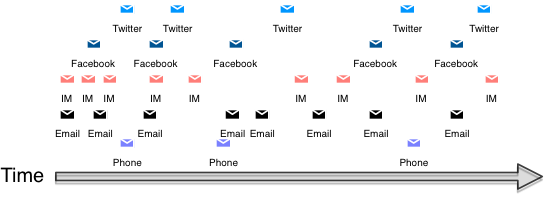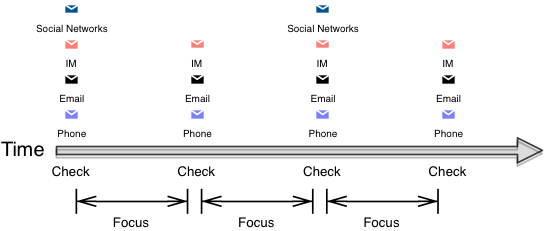
In our lives we have many inboxes, not just for our email. Our inboxes are all channels where unsorted and prioritized information comes in. If you think about it you will see, that there are lots of those: your family, friends, your boss, stuff that needs to be done at home and new ideas in your mind. Most people just let all those informations hail down on them. This can be okay for you. It just depends on the quantity of information and if you can handle it. If you can handle it, you are fine. But if you are e.g. in a key position or a node of information in your company, you will struggle to keep all your inboxes to zero. Here is my approach to deal with it.
Reduce the number of inboxes
First of all you need to know what exact inboxes you have. I recommend you to take a while to think about it and write them down. For me those inboxes are—just to name a few—email from work, my boss, my colleagues, Skype, email on my private account, phone, Facebook, Twitter, friends, stuff that needs to be done at home and stuff from my mind that passes by. That’s already a lot, isn’t it? So what can we do about it.
Step one: Take a look on which types of inboxes that are. Are they technical or human? If they are human you can let your colleagues and your boss know, that you prefer email over direct conversation or Skype, so you handle more stuff via your email inbox than over the other channels. Another good thing about turning human into technical inboxes is, that most technical inboxes like email enable asynchronous communication. Asynchronous communication helps you to minimize interruptions and to be more productive.
Step two: You can try to group inboxes into categories and always check them together. For me these are all the social networks.
Step three: If you are lucky you are able to kill one or more inboxes completely by substituting it. E.g. if you are using multiple types of instant messengers, you could use an application with interoperability between those like Adium or Trillian.
Find a rhythm
It’s a common mistake to check your inboxes all the time. This is very inefficient, because these are unnecessary interruptions on your work. It also increases multitasking and can cause a lot of stress over time.

Don’t do that. It depends on your job and somehow on your personality, but try to check your inboxes as seldom as possible until it hurts. For me it’s okay to check on my most urgent inboxes—like my email account at work—all thirty minutes. Other inboxes I check less frequently, like the social networks. You have to experiment here.
Here is my recommendation if you struggling to find a rhythm: If you are already using the Pomodoro Technique it’s easy. You can easily plug-in checking your inbox in the planning phase of each iteration. If not, use a free online timer like Moosti.com (it provides desktop notifications for Google Chrome) or a timer like this one (provides a visual or vibration alarm, so you don’t disturb anyone). Set it on the time you want to check your mail the next time, e.g. thirty minutes. Then start working on your task and really focus, keeping your mind free of any of your inboxes. As the alarm goes off, you stop what you are doing and check all of the inboxes you decide to check.

Some people say that it’s even a way conditioning the primitive part of your brain to work really focussed on a task and then give it a reward like checking your favorite social network (or whatever you enjoy). It is more likely then that your brain is able to repeat the next focussed phase with more ease, because it knows that the reward is coming after it. You can watch a short video about it here.
